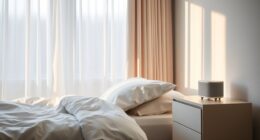So, your newborn has declared you as the designated sleep spot, huh? It can feel like a never-ending cycle of baby snuggles and sleepless nights, but fear not, we've got some tips to help you reclaim your personal space (and maybe even catch a few extra Z's).
From establishing a solid bedtime routine to introducing sleep-inducing techniques, these strategies could be the key to revealing the elusive domain of independent sleep for your little one.
Stay tuned to discover how these seven tips can transform your nighttime routine and bring sweet dreams back to your household.
Key Takeaways
- Establish a consistent sleep routine to teach newborn when to sleep and promote healthy habits.
- Create a sleep-inducing environment with dim lights and white noise for longer, quality sleep.
- Use swaddling techniques to mimic the womb, regulate body temperature, and promote uninterrupted sleep.
- Understand baby's wake windows, recognize tired signs, and create nap routines based on sleep cues.
Establishing a Sleep Routine
Establishing a consistent sleep routine is crucial for helping newborns learn when to sleep and promoting healthy sleep habits. Babies thrive on predictability, so incorporating calming activities like a warm bath, reading a bedtime story, or gentle massage can signal bedtime. These routines help your baby understand that it's time to wind down and prepare for sleep.
The consistency of a bedtime routine creates a sense of security and predictability, which aids in your baby's ability to self-soothe and fall asleep independently. When you follow a consistent routine, your baby learns to associate these activities with bedtime, making it easier for them to relax and drift off to sleep.
Creating a Sleep-Inducing Environment

When aiming to create a sleep-inducing environment for our newborns, we should dim the lights to foster calmness and comfort.
Ensuring the room is cozy and quiet can greatly aid in promoting restful sleep.
Utilizing a white noise machine can also provide a soothing background that helps babies stay asleep longer.
Dimming Lights for Calmness
To create a soothing atmosphere conducive to newborn sleep, consider dimming the lights to signal the body's natural production of melatonin, promoting relaxation and aiding in the onset of drowsiness. Dimming lights before bedtime can help regulate the circadian rhythm, leading to improved sleep quality and a smoother passage into restful slumber.
Reduced light levels create a calming ambiance ideal for promoting sleep and decreasing alertness, preparing your little one for a peaceful sleep. Here are a few simple tips to help you achieve the perfect sleep environment for your newborn:
- Use soft, warm lighting in the evening to signal bedtime.
- Install dimmer switches for adjustable light levels.
- Consider using blackout curtains to block out external light sources.
Comfortable and Cozy
Let's guarantee your newborn's sleep environment is cozy and comfortable, setting the stage for restful nights and peaceful naps.
Assure the room is dark, quiet, and kept at a comfortable temperature to promote deep sleep. Swaddles or sleep sacks can provide a sense of comfort and security, helping your baby feel snug and safe while sleeping.
Consider using white noise machines to create a soothing atmosphere that aids in sleep induction. Opt for gentle sleepsuits that are breathable and gentle on your baby's skin for added comfort.
Consistency is key, so using blackout curtains can help establish a conducive space for naps and nighttime sleep. Prioritize creating a cozy and secure sleep environment to help your newborn rest peacefully.
White Noise Machine
Creating a sleep-inducing environment with a white noise machine can greatly benefit your newborn's restful nights and peaceful naps. The consistent background sound provided by a white noise machine can effectively mask noises that may disrupt your baby's sleep, promoting relaxation and a quiet sleep environment. This steady sound can mimic the comforting sounds babies heard in the womb, signaling the brain that it's time to rest.
By utilizing a white noise machine, you can improve your baby's sleep quality by reducing night waking episodes. It's a practical and proven way to establish a soothing atmosphere that helps your little one drift off to sleep more easily and enjoy longer periods of uninterrupted rest.
- Mimics womb sounds for relaxation
- Reduces disruptions from external noises
- Signals brain to rest
Using Swaddling Techniques

Swaddling, a technique that mimics the snug feeling of the womb, is a valuable tool for promoting a sense of security and comfort for newborns. When done correctly, swaddling can prevent the Moro reflex, ensuring your baby stays asleep longer by reducing sudden waking. It also helps regulate your baby's body temperature, keeping them cozy and warm throughout the night. By providing this secure environment, swaddling can decrease the risk of Sudden Infant Death Syndrome (SIDS) and promote safe sleep practices. Additionally, swaddling has a calming effect on babies, leading to longer and uninterrupted sleep cycles, benefiting both the baby and parents.
| Benefits of Swaddling | Details |
|---|---|
| Mimics womb feeling | Promotes sense of security |
| Prevents Moro reflex | Reduces sudden waking |
| Regulates body temperature | Keeps baby comfortably warm |
Swaddling is a wonderful way to create a safe and comforting sleep environment for your little one, encouraging better sleep patterns and overall well-being.
Implementing White or Pink Noise

As we explore further ways to enhance your newborn's sleep environment, incorporating white or pink noise can be a beneficial strategy to promote deeper and more restful sleep for your little one. White or pink noise creates a soothing environment that mimics sounds babies heard in the womb, helping improve sleep quality and reduce disturbances throughout the night.
Here are some tips for implementing white or pink noise into your newborn's bedtime routine:
- Use a white noise machine or app to provide a constant, gentle sound that can mask other noises and lull your baby to sleep.
- Experiment with different volumes and types of white or pink noise to find what works best for your newborn's sleep patterns.
- Incorporate white or pink noise consistently as part of your baby's bedtime routine to establish a positive sleep association and promote longer, more restful sleep periods.
Understanding Baby's Wake Windows

Understanding your baby's wake windows is essential for optimizing their sleep routine and ensuring they get the rest they need to thrive. Babies, especially newborns, have short wake windows, typically lasting around 45-60 minutes before needing to nap. By paying attention to tired signs such as yawning, eye rubbing, or fussiness, you can better gauge when to put your baby down for a nap within this window.
To prevent overtiredness and promote better sleep, it's important to keep wake windows consistent and adjust them as your baby grows. This adjustment is important to meet their evolving sleep requirements and avoid disruptions in their sleep schedule.
Creating a nap routine based on your baby's sleep cues and wake windows can significantly contribute to establishing a healthy sleep pattern and enhancing overall sleep quality. By following these guidelines and being attentive to your baby's signals, you can help them get the rest they need for optimal development and well-being.
Introducing a Pacifier

Introducing a pacifier to your baby can be a comforting and beneficial addition to their sleep routine, promoting self-soothing behaviors and potentially reducing the risk of SIDS. Pacifiers offer a sense of comfort and security for babies, mimicking the feeling of being held close.
Here are some tips to help you introduce a pacifier effectively:
- Start Slow: Introduce the pacifier during naps or bedtime to help your baby associate it with sleep.
- Choose the Right Pacifier: Opt for a pacifier that's the correct size for your baby's age and development to assure comfort.
- Be Patient: Some babies may take time to adjust to a pacifier, so give them time to explore and get used to it.
Gradual Steps for Independent Sleep

When it comes to helping your newborn sleep independently, we suggest starting with a gentle bedtime routine.
Creating a familiar sleep environment and introducing a comforting intermediary object can also aid in this process.
These small steps can make a big difference in encouraging your baby to develop healthy independent sleeping habits.
Gentle Bedtime Routine
To establish a gentle bedtime routine for your newborn, gradually introduce calming activities like a warm bath, gentle massage, and soothing lullabies. Consistency in bedtime schedules helps signal to your baby that it's time to sleep. Implementing a wind-down period before bedtime can aid in relaxation and preparation for sleep.
Encouraging self-soothing by gradually reducing the need for being held during bedtime routines can promote independent sleep habits. Remember, these steps are about creating a soothing environment that encourages your baby to relax and feel secure as they drift off to sleep. By incorporating these elements into your routine, you can help your newborn learn to settle down and sleep more independently.
- Provide a warm bath
- Engage in a gentle massage
- Play calming lullabies
Familiar Sleep Environment
Shifting your newborn to independent slumber can be achieved through gradual steps focused on familiarizing them with the designated sleep environment. Starting with one nap a day in the bassinet or cot can help establish a routine and comfort in the new sleep space. By encouraging daily naps in the designated sleep area, your baby can begin to associate it with rest and relaxation. Consistent use of the bassinet or cot for most naps reinforces the change to independent sleeping habits. This approach creates a sense of familiarity and security for your little one, making the eventual full shift smoother. Remember, establishing a designated sleep space and routine is key to nurturing your baby's comfort and promoting independent sleeping habits.
| Familiar Sleep Environment | Benefits | Tips |
|---|---|---|
| Start with one nap a day in the bassinet or cot | Establishes routine and comfort | Begin with the first nap of the day |
| Encourage daily naps in the designated sleep space | Builds familiarity and routine | Aim for most naps in the bassinet or cot |
| Consistent use of the sleep space for naps | Reinforces shift to independent sleep | Maintain regularity for familiarity |
Comforting Transitional Object
After establishing a familiar sleep environment in the bassinet or cot, the next step towards self-reliant slumber involves introducing a comforting intermediary object to aid your baby's sense of security during sleep.
Here are some tips to help you navigate this phase:
- Choose Wisely: Select a comforting object like a soft blanket or toy that's safe and age-appropriate for your baby.
- Consistent Use: Incorporate the intermediary object into your baby's sleep routine consistently during naps and bedtime to create a positive association with independent sleeping.
- Bonding Time: Encourage your baby to bond with the intermediary object by including it in soothing rituals and bedtime routines for a smoother journey to independent sleep.
Conclusion
As parents maneuvering the challenging phase of a newborn who only wants to sleep on us, it's important to remember that patience and consistency are key.
By implementing the tips mentioned, we can gradually help our babies shift to independent sleep while still providing the comfort and reassurance they need.
Remember, Rome wasn't built in a day, so let's take it one step at a time and trust the process like planting seeds in a well-tended garden.









